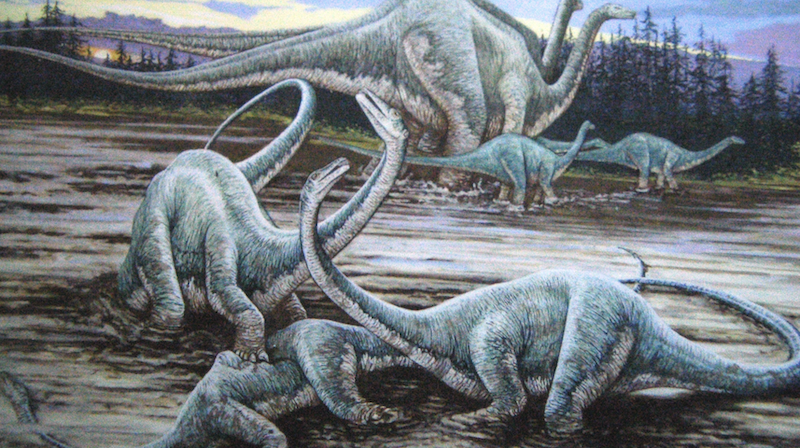Was there an intelligent civilization before humans existed?

- We assume that humans are the only technologically advanced species ever to have existed on Earth? Can we know that for sure?
- If another advanced civilization existed millions of years ago, almost every trace would have vanished by now.
- Still, if we never look for such evidence, or rule out the possibility that it could even exist, we’ll never find it.
We humans feel very confident that we are the most intelligent species that ever walked the face of the Earth. Top of the evolutionary chain? No doubt about it. But come to think of it, how do we know that for certain?
Let’s imagine for a moment that some civilization went extinct millions of years before hominids even appeared. Although there isn’t a precise definition of “civilization,” we usually associate it with a species capable of altering its physical environment on a regional or even planetary scale. How would we know, millions of years later, that they had been here?
All evidence of their technological achievements is almost certain to have disappeared long ago, as persuasively shown by Alan Wiseman in his 2007 book, The World Without Us. Cities and large constructions like dams would quickly crumble and return to rubble. Farms and parks would become forest or jungle. And if this pre-human civilization had technology similar to ours, most of it would simply vanish — even plastic trash eventually decays due to UV radiation and bacteria. Large structures fare no better. In a few million years, Mount Rushmore will look just like any other mountain.
Very little remains from the Neanderthals, who lived just a few tens of thousands of years ago. Even very recent, very advanced human civilizations, like those of pre-Columbian America, made most of their constructions from organic materials like wood, so that evidence is hard to come by after only a few hundred years.
What if a much more ancient civilization — pre-dating humans — achieved some level of technology? Let’s take dinosaurs, for example. Star Trek played with that idea in an episode more than 20 years ago, so let’s explore it a little further.
Dinosaur civilization
Back when I was in high school (speaking of ancient history!), my teacher told us that brontosaurs must have been incredibly dumb, because they had a brain the size of a matchbox. Even then, I thought this conclusion a bit misguided. Brontosaurs had enough “intellectual capability” to control and navigate a 30-ton body, find food, avoid predators, and do all the other things that big and complex animals need to do.
At the time, scientists hadn’t discovered that (avian) dinosaurs were the ancestors of birds. So perhaps we should reconsider their reputation as stupid. Birds have small brains because they need to fly, but many are quite intelligent, especially crows and parrots. How do they do it? The neurons in their brain are much more closely packed, and they have several times more neurons per gram of brain compared to mammals. Avian dinosaurs like the theropods may well have had the same brain structure — we don’t know for sure, because brains don’t fossilize — and therefore may have been much smarter than we once thought.
Some highly intelligent birds also use tools. Recently I saw two crows at a train station in Potsdam, near where I live. One was pushing the button on the water dispenser with its beak, while the other crow drank the water that was trickling out. They must have observed humans pushing the button to drink. This is clearly intelligent behavior and demonstrates their ability to use tools. Even crocodiles, who are related to the non-avian dinosaurs, recently have been shown to use tools. It doesn’t seem impossible that dinosaurs did as well.
If some dinosaurs did indeed develop technology, which species would have been most likely to take that step? The smartest ones are usually thought to be the troodons, bird-like dinosaurs from the late Cretaceous period. They fit many of the requirements we usually look for in a technologically advanced species. Not only were they intelligent (based on the size of their brains), but they were very social. They had long arms with “hands” and “fingers,” which may have given them enough dexterity to handle tools and manipulate objects.
No evidence of existence
The troodons became extinct toward the end of the Cretaceous period about 65 million years ago, along with many other dinosaurs, when a large asteroid struck Earth. If they did develop technology, what signs of it might remain after such a catastrophe, not to mention thousands of millennia of ordinary geologic upheaval and erosion?
First off, it would be hopeless to find evidence of constructed “buildings” from 65 million years ago. If they liked shiny things as much as humans do, maybe they manufactured jewelry from gold or another noble metal. Perhaps we might still find radioactively enriched areas if they were advanced enough to use nuclear fission. If they got as far as space travel, maybe we could find their abandoned spacecraft on the Moon or Mars, where weathering wouldn’t have erased the evidence.
Obviously, we have found nothing remotely like this, at least not yet. No 65-million-year-old necklaces. There are in fact uranium-enriched regions on Earth — one of which, the Oklo deposit in Gabon, undergoes natural fission — but they don’t fit the timeline.
Still, if we never look for such evidence, or rule out the possibility that it could even exist, we’ll never find it. For now, when we say humans are the only species on our planet that evolved technological intelligence, I maintain that we may want to add the word “probably.”





